Consumer Behavior
Introduction
Consumer behavior refers to the study of how individuals, groups, and organizations select, buy, use, and dispose of goods, services, ideas, or experiences to satisfy their needs and wants. It blends elements from psychology, sociology, social anthropology, marketing, and economics. It attempts to understand the decision-making processes of buyers, both individually and in groups such as how emotions affect buying behavior, how the consumer is influenced by his or her environment (e.g., culture, family, signs, media), how motivation and decision strategies differ between products that differ in their level of importance or interest that they entail for the consumer, and how marketers can adapt and improve their marketing campaigns and marketing strategies to more effectively reach the consumer read more.
Theoretical Models of Consumer Behavior
Several models have been proposed to understand the decision-making process of consumers. These models include the Howard-Sheth Model, the Engel-Blackwell-Miniard Model, and the Nicosia Model. These models suggest that consumer behavior involves a complex interplay of factors, including the consumer's knowledge, information processing abilities, motivations, emotions, and social influences.
Howard-Sheth Model
The Howard-Sheth model of consumer behavior suggests that consumer decision-making involves a series of cognitive processes. The model proposes that consumers go through several stages, including need recognition, information search, evaluation of alternatives, purchase decision, and post-purchase behavior. The model also suggests that consumer behavior is influenced by various factors, including the consumer's psychological characteristics, social influences, and situational factors.
Engel-Blackwell-Miniard Model
The Engel-Blackwell-Miniard model of consumer behavior is a comprehensive model that includes several factors that influence consumer behavior. The model suggests that consumer decision-making involves a series of stages, including problem recognition, information search, alternative evaluation, purchase decision, and post-purchase behavior. The model also includes several factors that influence consumer behavior, including individual differences (e.g., personality, lifestyle), environmental influences (e.g., culture, social class), and psychological processes (e.g., motivation, perception, learning, attitude formation).
Nicosia Model
The Nicosia model of consumer behavior is a comprehensive model that includes several factors that influence consumer behavior. The model suggests that consumer decision-making involves a series of stages, including problem recognition, information search, alternative evaluation, purchase decision, and post-purchase behavior. The model also includes several factors that influence consumer behavior, including individual differences (e.g., personality, lifestyle), environmental influences (e.g., culture, social class), and psychological processes (e.g., motivation, perception, learning, attitude formation).
Factors Influencing Consumer Behavior
Consumer behavior is influenced by various factors, including cultural, social, personal, and psychological factors. These factors are not controlled by marketers but must be taken into account as they affect the consumer decision-making process.
Cultural Factors
Cultural factors exert the broadest and deepest influence on consumer behavior. The marketer needs to understand the role played by the buyer's culture, subculture, and social class. For example, culture can be defined as the learned values, perceptions, wants, and behavior from family and other important institutions. A child growing up in the US is exposed to individualism, freedom, and equality. On the other hand, a child growing up in a traditional society in Asia is exposed to the values of obedience, duty, and respect for authority read more.
Social Factors
A consumer's behavior is also influenced by social factors, such as the consumer's small groups, family, and social roles and status. The small groups include friends, family, and reference groups. For a group to influence a person's attitude or behavior, it needs to be credible, knowledgeable, and accessible. The family members can strongly influence buyer behavior. It can influence the buying behavior of the individual in two ways. First, the parents can influence the buying behavior of their children. Second, the children can influence the buying behavior of their parents read more.
Personal Factors
Personal factors can also affect the consumer behavior. Some of the important personal factors that influence the buying behavior are lifestyle, economic situation, occupation, age, personality and self-concept. Age and life-cycle have a potential impact on the consumer buying behavior. For example, young people purchase things for different reasons than older people. Economic situation such as personal income, savings, and interest rates affect consumer behavior. Occupation affects the buying behavior of consumers. For example, a marketing manager of an organization will try to purchase business suits, whereas a low-level worker in the same organization will purchase rugged work clothes read more.
Psychological Factors
A person's buying choices are influenced by four major psychological factors: motivation, perception, learning, and beliefs and attitudes. Motivation is the driving force within individuals that impels them to action. This driving force is produced by a state of tension that exists as the result of an unfulfilled need. Perception is the process by which an individual selects, organizes, and interprets information inputs to create a meaningful picture of the world. Learning describes changes in an individual's behavior arising from experience. Beliefs and attitudes are the internal factors that influence consumer behavior read more.
Consumer Decision Making Process
The consumer decision making process involves five basic steps: need recognition, information search, evaluation of alternatives, purchase decision, and post-purchase behavior.
Need Recognition
The buying process starts with need recognition. At this stage, the buyer recognizes a problem or need. The need can be triggered by internal stimuli when one of the person's normal needs—hunger, thirst, sex—rises to a level high enough to become a drive. A need can also be triggered by external stimuli.
Information Search
An aroused consumer will be inclined to search for more information. A person at this stage may simply have heightened attention or may go into an active information search. The amount of search depends on the strength of the drive, the amount of initial information, the ease of obtaining more information, the value placed on additional information, and the satisfaction derived from searching.
Evaluation of Alternatives
After gathering the information, the consumer clarifies and evaluates the alternatives. This stage is the one where the consumer engages in both internal and external information search.
Purchase Decision
In the evaluation stage, the consumer forms preferences among the brands in the choice set. The consumer may also form an intention to buy the most preferred brand. The consumer's purchase decision will be to buy the most preferred brand, but two factors can come between the purchase intention and the purchase decision. The first factor is the attitudes of others. The second factor is unexpected situational factors.
Post-Purchase Behavior
After purchasing the product, the consumer will experience some level of satisfaction or dissatisfaction. The marketer’s job does not end when the product is bought. After purchase, the consumer will be satisfied, dissatisfied, or somewhere in between.
Conclusion
Understanding consumer behavior is a vital aspect of marketing. Consumer behavior is a complex interplay of factors that influence the decision-making process of consumers. Marketers need to understand these factors and how they influence consumer behavior to effectively market their products and services.
See Also
- Consumer Psychology
- Culture and Consumer Behavior
- Social Influence and Consumer Behavior
- Personal Factors and Consumer Behavior
- Psychological Factors and Consumer Behavior


